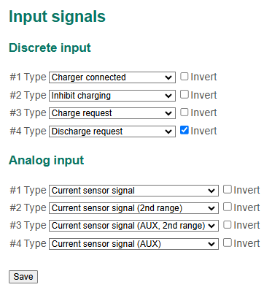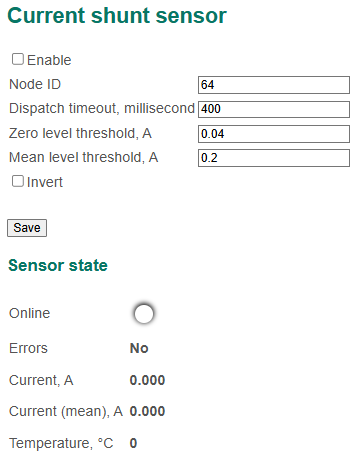3.3.1 Input signals
The BMS Main 2.x board has 4 discrete inputs of the "dry contact" type. For each discrete input, its purpose and the inversion requirement are specified. The following discrete input assignment options are supported:
- no signal;
- signal from battery cover;
- charger connected;
- power up/down request;
- inhibit charging;
- inhibit discharging;
- CH contactor feedback;
- DCH contactor feedback;
- Insulation status;
- Charge request;
- Precharge request;
- Discharge request;
- PCH contactor feedback;
- CH/DCH contactor feedback;
- Main contactor feedback.
If the "Signal from the battery cover" assignment is selected, the discrete input is used to monitor the state of the battery cover (see section Battery cover protection).
if the "Charger connected" assignment is selected, the discrete input is involved in the algorithms of charge and discharge control (see sections Charge control and Discharge control).
If the "Power up/down request" assignment is selected, the discrete input is involved in the algorithms of opening the charging and discharging relays and sending acknowledgment of power down to the external equipment (see sections Charge control and Discharge control).
If the “Inhibit charging” assignment is selected, the discrete input is used to open the charging relay.
If the “Inhibit discharging” assignment is selected, the discrete input is used to open the discharging relay.
If the “CH contactor feedback”, “DCH contactor feedback”, “PCH contactor feedback”, “CH/DCH contactor feedback” or “Main contactor feedback” assignment is selected, the discrete input is involved in monitoring the corresponding contactor’s feedback signal (see section Contactor feedback check).
If the “Charge request”, “Precharge request” or “Discharge request” assignment is selected, the discrete input is used to control opening the corresponding contactor (see sections Charge control and Discharge control).
If the “Insulation status” assignment is selected, the discrete input is used to monitor a signal from an external insulation monitoring device (see section Insulation monitoring).
BMS Main 2.x board has 4 analog inputs for connecting current, temperature and humidity sensors. Assignment of analog inputs must be selected as follows:
- Analog Input #1 – Current sensor;
- Analog Input #2 – No input / Current sensor reference line / Current sensor (2nd range) (see note);
- Analog Input #3 – No input / Temperature sensor / Current sensor (AUX);
- Analog Input #4 – No input / Humidity sensor / Current reference line (AUX) / Current sensor (2nd range) (AUX).
To configure the input discrete and analog signals, select the menu "Signals → Input signals":

Input signals section
The order of the numbering of the discrete and analog inputs corresponds to the order of the numbering on the board.
In this section:
- Discrete inputs:
- No input;
- Battery cover – a signal from the battery cover trailer;
- Charger connected – a signal from the charger connector;
- Power up/down request – a signal from the external power monitor which is used for proper powering BMS up or down;
- Inhibit charging – a command to open the charging relay;
- Inhibit discharging – a command to open the discharging relay;
- CH contactor feedback – a feedback signal from the charging contactor;
- DCH contactor feedback – a feedback signal from the discharging contactor;
- Insulation status – a signal from an external insulation monitoring device;
- Charge request – a request for closing the charging contactor;
- Precharge request – a request for closing the precharging contactor;
- Discharge request – a request for closing the discharging contactor;
- PCH contactor feedback – a feedback signal from the precharging contactor;
- CH/DCH contactor feedback – a feedback signal from the charging/discharging contactor;
- Main contactor feedback – a feedback signal from the main contactor.
- Analog inputs:
- No input;
- Current sensor;
- Current zero level;
- Temperature sensor;
- Humidity sensor;
- Current sensor (AUX) – additional current sensor for measuring current in a series of cells;
- Current zero level (AUX) – zero level bus for additional current sensor.
3.3.2 Current sensor
After selecting the assignment of the analog inputs, you need to configure the parameters of the sensors connected to the board.
To configure the current sensor parameters, select the menu "Signals → Current sensor":

Current sensor settings
In the «Primary sensor» и «Auxiliary sensor» sections:
- Sensor type – drop-down menu with supported sensor types;
- Nominal current – rated current of the sensor according to the datasheet, А;
- Sensitivity – sensitivity of the current sensor according to the datasheet, V / Inominal.;
- Zero level – level "0A" of the current sensor, V;
- Multiply the charging current (experimental) – experimental flag for scaling the charging current by given multiplier;
- Multiplier – charging current multiplier;
In the «Options» section:
- Calibrate sensor on startup – calibration flag (zero level setting) of the current sensor when the board is started;
- Calibration time – calibration time of the current sensor, second;
- System consumption (current offset) – consumption of the BMS system from the battery, A; This setting is used to adjust the current sensor;
- Set sensor zero level – command set the zero level of the current sensor (used for service purposes).
Calibration of the current sensor (“Calibrate sensor on startup” flag) is necessary if the sensor does not have a reference line (zero level signal).
3.3.3 Current shunt sensor
To configure the shunt current sensor parameters, select the menu "Signals → Current shunt sensor":

